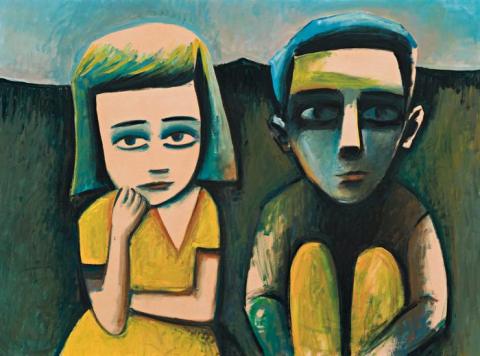SEATED CHILDREN IN LANDSCAPE, c.1953-54
Charles Blackman
oil on paper on board
90.0 x 121.0 cm
signed lower left: BLACKMAN
Private collection, Melbourne
Double Self Portrait, 1954, oil and enamel on paper, 96.0 x 132.0 cm, Shapcott, T., The Art of Charles Blackman, André Deutsch, London, 1989, pp. 16, 249, cat. 34 (illus. p. 16)
Charles Blackman's paintings reveal an extraordinary understanding of childhood and children, Children in a Landscape being a fine example from a particularly rich period in his art. Pensive and wide-eyed, they look directly out of the picture, but their presentation suggests that their thoughts are elsewhere. As images of isolation emphasised by the emptiness of their surroundings, their vulnerability is compounded by the utter stillness if not timelessness of the setting. If melancholy touches the face of the young girl, the boy is more direct in his unblinking gaze. Appearances, however, are merely the starting point for Blackman's art of ideas, the poignant image the doorway to other things. Judith Wright summed up his art perfectly. 'His painting is not the world of things, but of the world of our experience of them, in which they are changed from things to meanings.'1
Perhaps Blackman's greatest talent is to be able to see the world in terms of childhood. To this he adds a poeticism of colour and composition, the metaphors of his meaning being the beauty of youth found in the figures of young people, especially girls, of flowers, gardens, and cats asleep. While terrors unknown may stalk the empty streets and lanes of his deeply moving 'School Girl' series, the beauty and innocence of childhood blossoms in 'Alice in Wonderland', a superb visual counterpoint to the words of Lewis Carroll and the world of make-believe, separated by the merest thinness from that of reality. It is the world of dreams where dragon darkness is dissolved in light, and flowers are mightier than the sword. Levitation is as natural for the participants as walking, or just plain sitting still, as in this painting. But they have now grown from childhood to young teenagers. Both are at the threshold of puberty and its accompanying worldly knowledge, awareness and bewilderment. The girl, Blackman's Alice-to-be, expresses innocence and intelligence in her perception of a world that is baffling in all its complexities and contradictions. The boy, the emerging artist, is more earthbound, the metaphor of the emerging everyman, with the fixed look of the observer ready to see and record with courage and compassion. It was Barry Humphries who wrote of Blackman's art with words that fit this painting so well. 'No other artist in the world can measure with such tenderness these breathless seconds when a human figure suddenly apprehends and is overwhelmingly moved by the emotion of its environment.'2
1. Wright, J., 'Foreword', Charles Blackman, Johnstone Gallery, Brisbane, June 1957
2. Humphries, B., New Paintings, Charles Blackman, South Yarra Gallery, 1966
DAVID THOMAS
